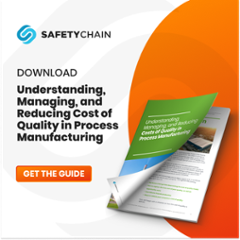The Staggering Cost of Poor Quality: How to Measure & Address It
Poor quality can waste a considerable portion of an organization’s operating budget. Alarmingly, some manufacturers even have the cost of poor quality factored into their budget, meaning these companies are willing to allow it to persist in plain sight and hinder their overall performance.
While there will always be some factors that affect quality to a certain degree, identifying and addressing the factors contributing to poor quality is critical. This ensures competitiveness, supports ongoing improvement efforts, and minimizes waste. Here’s a closer look at the unexpected costs related to poor quality, as well as how to measure and address them with a cost of quality analysis.
Why Perform a Cost of Quality Analysis?
The vulnerability of complex international supply chains and overt Chinese threats to disrupt U.S. supply chains underscore the need to re-shore manufacturing capability as rapidly as possible. In 2019, for example, Beijing threatened to withhold the rare earth metals necessary for manufacturing electric cars, then life-saving medicines in 2020. Reduction of domestic costs, including (but not limited to) costs of poor quality, will help to support and encourage re-shoring.
Interestingly, some industries even have the cost of quality (COQ) clauses built into their management standards. For instance, IATF 16949 clause 9.3.2.1(a) for the automotive industry requires the cost of poor quality as input for management review. Simply put, supply chains don’t want to pay for poor quality.
How the Cost of Poor Quality Can Affect Competitiveness
Poor quality massively affects supply chains, because its costs impact overall competitiveness of any given company which is why manufacturers have consistently focused on quality assurance. However, if you are not also considering your cost of poor quality, you are truly missing a major piece. Consider the fact that poor quality wastes 25% to 35% of typical operating budgets, including opportunity costs. What would these opportunities look like if they were distributed to customers in the form of lower prices? Or, how would this look if you could provide higher wages to employees and higher profits to investors—without the need to increase sales?
What Contributes to the Cost of Poor Quality?
Several factors contribute to the cost of poor quality. Lost time is one major factor to consider. Henry Ford said:
“Time waste differs from material waste in that there can be no salvage. The easiest of all wastes, and the hardest to correct, is the waste of time, because wasted time does not litter the floor like wasted material.”
The four pillars of waste that raise the cost of quality include:
The Time of People
The Time of Things
Materials
Energy
The point at which the problem arises in manufacturing is also an essential factor in poor quality. When nonconforming work escapes its point of origin to become an input for downstream processes, the cost of poor quality multiples, often by orders of magnitude; for example, suppose a food product must be recalled because a consumer safety issue such as salmonella or Hepatitis A was not detected or prevented. In that case, it will be much more expensive to address than if the issue had been identified before shipment. In other words, the more time passes, the costlier poor quality becomes. This principle is known as the Rule of 10s, which also states that only 15% of problems—fewer than one in six—are discovered at their point of origin. The other 85% are discovered further down the line, where their consequences are more expensive.
Manufacturers should therefore adopt the principle of “Don’t take it, don’t make it, and don’t pass it along”:
Don’t take it: Don’t accept nonconforming inputs.
Don’t make it: Don’t produce nonconforming work.
Don’t pass it along: Don’t ship nonconforming work to the next process (internal or customer).
Using modern technology, including automated quality management systems with sensors, scales, and other metrics-gathering devices as well as control charts, instant alerts, and data visualizations, is essential to detecting and stopping poor quality at its point of origin—or even better, preventing its generation.
What Are the Four Costs of Quality?
To effectively address quality issues in your plant, you must first know how to measure them. Before you can do that, however, you must know where the costs of quality originate. Traditionally, the four costs of quality have included:
Cost of prevention
Cost of appraisal
Cost of internal failure
Cost of external failure
Failure costs increase the further from their point of origin the problems are detected.
How Can You Calculate Cost of Quality?
Poor quality is only one form of waste, and it’s the only one that’s likely to announce its presence, whether caught through automation, self-check systems, or successive check systems. Other forms of waste do little or nothing to announce their presence but can cost even more than poor quality and may be built into the job. One other example is asymptomatic waste, or the cost of any material or energy that goes into a process and does not come out as a saleable product. An example of this would be the fertilizer that doesn’t reach the plants in an agricultural operation but instead turns into runoff. Fortunately, it’s possible to uncover other areas of waste by accurately and consistently calculating COQ.
There are several methods to calculate COQ:
The Whole Account Method
This method uses accounting data related to poor quality, such as costs of warranty, scrap, overtime labor, and downtime costs. Yet, this method fails to consider opportunity costs, which are invisible to cost accounting systems. After all, accounting systems are designed to prepare tax statements and financial reports, not guide operational decision-making. For example, labor is a fixed cost unless overtime is being paid. Similarly, overhead is a sunk cost, which means it does not count toward the cost of poor quality.
The Whole Person Method
This technique quantifies full-time equivalent employees whose work (including a rework of nonconforming work, replacement of scrap, etc.) is related to the cost of poor quality. Yet, like The Whole Account Method, it could overlook factors such as performance loss caused by other inefficiencies.
Unit Pricing
Another technique widely used in the auto industry, unit pricing uses cost accounting methods by calculating standard costs for undesirable events and then multiplying them by the number of times the events take place. These costs may not necessarily account for all costs, however (especially opportunity costs).
Labor Claiming Method
This method seeks to quantify the amount of time that all employees spend on activities related to the cost of poor quality.
Deviation From Ideal
This comes across as a form of gap analysis that assesses the difference between actual performance and achievable performance.
Addressing Cost of Quality With Ford’s Key Performance Indicators
Clearly, none of the methods for measuring COQ is completely foolproof. No matter which method you use, you can get a complete idea of the cost of poor quality in your plant by looking at Ford’s four waste measurements.
Ford liked to measure the waste of:
The Time of Things
Any cycle time that doesn’t involve an actual transformation of the work. This would include non-value-adding activities, such as setup and wait time, as well as inventory.
The Time of People
Ford believed that people should not be paid to walk or wait. For that reason, designing your factory to facilitate an efficient flow of traffic could help eliminate this cost.
Materials
Whether stock or consumable, any material that goes into a process and does not come out as a saleable product is waste. A dollar not spent on wasted materials is a dollar of profit that can be distributed to investors, employees, and customers, while it might take an additional $10 in sales to generate the same dollar.
Energy
The energy that does not transform the product is waste. A hydraulic machine tool that draws power to keep its fluids under compression regardless of whether it is actually making anything is an example of wasted energy.
In Conclusion
There are numerous off-the-shelf techniques available to identify the cost of poor quality. However, these often overlook opportunity costs. By applying Ford’s KPIs, you can force other sources of waste to become visible and to improve your facility’s overall quality as well as its profits.



